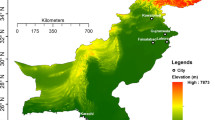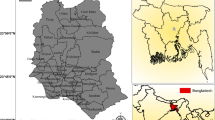Abstract
To study the urban heat island (UHI) effect in the mountainous areas of Chongqing, the UHI indexes for the Chongqing urban agglomerations were investigated in the present study. This study is based on data from 34 national weather stations and more than 2000 regional automated weather stations in Chongqing, Defense Meteorological Satellite Program/Operational Linescan System (DMSP/OLS) nighttime light data, and 30-m high-resolution land use data and Moderate Resolution Imaging Spectroradiometer (MODIS) land surface temperature remote sensing data for Chongqing in 2015. Moreover, the influences of three background temperature calculation methods on the UHI effect were compared. The results showed that, if only the land use data and the city clustering algorithm (CCA) were used to divide the urban and suburban areas, the strong UHI index of Chongqing exhibited an abnormal increase in the years with extremely high temperatures, and the corresponding divided suburban and urban areas had relatively large differences in altitudes, thereby overestimating the UHI index. Therefore, in the present study, a new method for dividing the urban and suburban areas based on the combined CCA and light intensity data and a division method with the altitudes calibrated on this basis were designed. Both methods were able to satisfactorily reduce the influence of extreme climate years and excessively large differences in altitudes on the UHI index calculations and provide a new approach for future studies of the UHI index for mountainous areas with large altitude differences.









Similar content being viewed by others
References
Alonso MS, Fidalgo MR, Labajo JL (2007) The urban heat island in Salamanca (Spain) and its relationship to meteorological parameters. Clim Res 34:39–46
Arnfield AJ (2003) Two decades of urban climate research: a review of turbulence, exchanges of energy and water, and the UHI. Int J Climatol 23:1–26
Basara JB, Hall PK, Schroeder AJ et al (2008) Diurnal cycle of the Oklahoma City urban heat island. J Geophys Res 113:D20109
Castaldo VL, Coccia V, Cotana F, Pignatta G, Pisello AL, Rossi F (2015) Thermal-energy analysis of natural “cool” stone aggregates as passive cooling and global warming mitigation technique. Urban Clim 14:301–314
Chen SL, Wang TX (2009) Comparison analyses of equal interval method and mean-standard deviation method used to delimitate urban heat island. Geo-information Sci 11(2):145–150
Cheng BY et al (2012) Technical manual of climate operations in Chongqing. China Meteorological Press, Beijing, 275 pp
Crosson WL, Al-Hamdan MZ, Hemmings SNJ et al (2012) A daily merged MODIS Aqua–Terra land surface temperature data set for the conterminous United States. Remote Sens Environ 119:315–324
Dong LP, Jiang ZH, Shen SH (2014) Urban heat island change and its relationship with urbanization of urban agglomerations in Yangtze River Delta in past decade. Trans Atmos Sci 37(2):146–154
Fenner D, Meier F, Scherer D, Polze A (2014) Spatial and temporal air temperature variability in Berlin, Germany, during the years 2001–2010. Urban Clim 10:308–331
Ganbat G, Han JY, Ryu YH, Baik JJ (2013) Characteristics of the urban heat island in a high-altitude metropolitan city, Ulaanbaatar, Mongolia. Asia-Pacific J Atmos Sci 49:535–541
Gedzelman SD, Austin S, Cermak R, Stefano N, Partridge S, Quesenberry S, Robinson DA (2003) Mesoscale aspects of the urban heat island around New York City. Theor Appl Climatol 75:29–42
He CY et al (2005) The urbanization model a process in Bohai Sea surrounding area in the 1990s by using DMSP/OLS data. Acta Geogr Sin (in Chinese) 60(3):409–417
Hu XM, Xue M, Klein PM, Illston BG, Chen S (2016) Analysis of urban effects in Oklahoma City using a dense surface observing network. J Appl Meteorol Climatol 55:723–741
Husain SZ, Belair S, Mailhot J et al (2013) Improving the representation of the nocturnal near-neutral surface layer in the urban environment with a mesoscale atmospheric model. Bound-Layer Meteor 147:525–551
Jiang P, Liu XR, Zhu HN et al (2019) Features of urban heat island in mountainous Chongqing from a dense surface monitoring network. Atmosphere. 10(2):67
Jin PB, Xu PF (2017) A study of urbanization progress and spatial pattern using DMSP/OLS nighttime light data: a case study of Hangzhou City. Remote Sens Land Resour 29(4):205–213
Kamal S et al (2015) The influence of urbanization on the climate of the Las Vegas Metropolitan. J Appl Meteorol Climatol 54(1):2157–2177
Magee N, Curtis J, Wendler G (1999) The urban heat island effect at Fairbanks, Alaska. Theor Appl Climatol 64:39–47
Miao SG, Chen F, Lemone MA et al (2009) An observational and modeling study of characteristics of urban heat island and boundary layer structures in Beijing. J Appl Meteorol Climatol 48:484–501
Morini E, Touchaei AG, Rossi F, Cotana F, Akbari H (2018) Evaluation of albedo enhancement to mitigate impacts of urban heat island in Rome (Italy) using WRF meteorological model. Urban Clim 24:551–566
Nouri AS, Costa JP, Santamouris M et al (2018) Approaches to outdoor thermal comfort thresholds through public xpace design: a Review. Atmosphere 9:108
Oke TR (1976) The distinction between canopy and boundary layer UHIs. Atmosphere (Basel) 14:268–277
Oke TR (1981) Canyon geometry and the nocturnal urban heat island: comparison of scale model and field observations. Int J Climatol 1:237–254
Oke TR (1982) The energetic basis of the urban heat island. Q J R Meteorol Soc 108:1–24
Peng S, Piao S, Ciais P et al (2012) Surface UHI across 419 global big cities. Environ Sci Technol 46(2):696–703
Philandras CM, Metaxas DA, Nastos PT (1999) Climate variability and urbanization in Athens. Theor Appl Climatol 63:65–72
Scott A, Waugh DW, Zaitchik B et al (2018) Reduced UHI intensity under warmer conditions. Environ Res Lett 13(6)
Steeneveld GJ, Koopmans S, Heusinkveld BG, van Hove LWA, Holtslag AAM (2011) Quantifying urban heat island effects and human comfort for cities of variable size and urban morphology in the Netherlands. J Geophys Res 116:D20129
Wienert U, Kuttler W (2005) The dependence of the urban heat island intensity on latitude—a statistical approach. Meteor Z 14:677–686
Yang P, Ren G, Liu W (2013) Spatial and temporal characteristics of Beijing urban heat island intensity. J Appl Meteorol Climatol 52:1803–1816
Yang J, Kumar DIM, Pyrgou A et al (2018) Green and cool roofs’ urban heat island mitigation potential in tropical climate. Sol Energy 173:597–609
Yow DM, Carbone GJ (2006) The urban heat island and local temperature variations in Orlando, Florida. Southeast Geogr 46:297–321
Zhao M et al (2018) Assessing spatiotemporal characteristics of urbanization dynamics in Southeast Asia using time series of DMSP/OLS nighttime light data. Remote Sens 10(1)
Zhuo L et al (2006) Identification and characteristics analysis of urban land expansion types in China in the 1990s using DMSP/OLS data. Acta Geograph Sin 61(2):169–178
Acknowledgments
This study of UHI index methods for urban agglomerations (on hilly terrains) in Chongqing provides a new approach for applying this index to mountainous areas with large altitude differences in future studies. We are especially grateful to the Chongqing Meteorological Information and Technology Support Center for providing temperature data from 34 national weather stations and over 2000 regional automated weather stations in Chongqing. We would also like to thank Dr. Xiaochun Liu for performing textual translations.
Funding
Financial support for this research study was provided by the Chongqing Meteorological Administration.
Author information
Authors and Affiliations
Corresponding author
Additional information
Publisher’s note
Springer Nature remains neutral with regard to jurisdictional claims in published maps and institutional affiliations.
Rights and permissions
About this article
Cite this article
Liao, D., Zhu, H. & Jiang, P. Study of urban heat island index methods for urban agglomerations (hilly terrain) in Chongqing. Theor Appl Climatol 143, 279–289 (2021). https://doi.org/10.1007/s00704-020-03433-8
Received:
Accepted:
Published:
Issue Date:
DOI: https://doi.org/10.1007/s00704-020-03433-8




